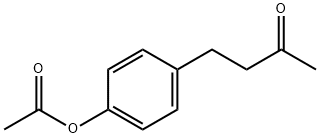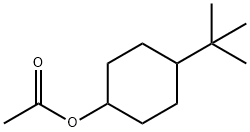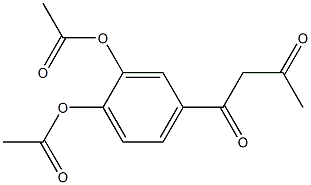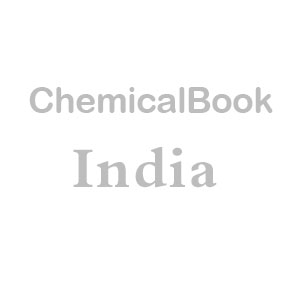4-(4-Acetoxyphenyl)-2-butanone
Synonym(s):4-(3-Oxobutyl)phenyl acetate;4-(4-Acetoxyphenyl)-2-butanone;Cue-lure;Q-lure;raspberry ketone acetate
- CAS NO.:3572-06-3
- Empirical Formula: C12H14O3
- Molecular Weight: 206.24
- MDL number: MFCD00008704
- EINECS: 222-682-0
- SAFETY DATA SHEET (SDS)
- Update Date: 2025-01-27 09:38:02

What is 4-(4-Acetoxyphenyl)-2-butanone?
Chemical properties
A yellow liquid with sweet, raspberry, fruity odor
The Uses of 4-(4-Acetoxyphenyl)-2-butanone
As attractant in melon fly traps.
The Uses of 4-(4-Acetoxyphenyl)-2-butanone
4-(3-Oxobutyl)phenyl Acetate is a sexual attractant. Pheromone.
The Uses of 4-(4-Acetoxyphenyl)-2-butanone
4-(3-Oxobutyl)phenyl acetate was used as attractant for detection programs aimed at melon fly and other cuelure-responding Bactrocera fruit flies.
What are the applications of Application
Cuelure is an insect sex hormone
Definition
ChEBI: Cuelure is a benzoate ester and a member of phenols.
General Description
4-(3-Oxobutyl)phenyl acetate (4-(4-acetoxyphenyl) -2-butanone) is a standard melon fly attractant.
Safety Profile
Moderately toxic by ingestion.When heated to decomposition it emits acrid smoke andirritating fumes.
Properties of 4-(4-Acetoxyphenyl)-2-butanone
| Boiling point: | 123-124 °C0.2 mm Hg(lit.) |
| Density | 1.099 g/mL at 25 °C(lit.) |
| refractive index | n |
| FEMA | 3652 | 4-(P-ACETOXYPHENYL)-2-BUTANONE |
| Flash point: | >230 °F |
| storage temp. | Sealed in dry,Room Temperature |
| form | neat |
| form | Liquid |
| color | Colorless to Light yellow |
| Odor | at 100.00 %. berry jam raspberry blueberry |
| JECFA Number | 731 |
| Merck | 14,2616 |
| BRN | 1961620 |
| CAS DataBase Reference | 3572-06-3(CAS DataBase Reference) |
| NIST Chemistry Reference | 4-(p-Acetoxyphenyl)-2-butanone(3572-06-3) |
| EPA Substance Registry System | 4-(4-(Acetyloxy)phenyl)-2-butanone (3572-06-3) |
Safety information for 4-(4-Acetoxyphenyl)-2-butanone
| Signal word | Danger |
| Pictogram(s) |
 Exclamation Mark Irritant GHS07  Health Hazard GHS08  Environment GHS09 |
| GHS Hazard Statements |
H402:Hazardous to the aquatic environment, acute hazard |
| Precautionary Statement Codes |
P273:Avoid release to the environment. P501:Dispose of contents/container to..… |
Computed Descriptors for 4-(4-Acetoxyphenyl)-2-butanone
4-(4-Acetoxyphenyl)-2-butanone manufacturer
Axon IPM
Andhra Pradesh
Phone:91-7893343396
Whatsapp: 91-7893343396
product: 4-(4-Acetoxyphenyl)-2-butanone
New Products
3-Iodophenylacetic acid 3-Pyridineacetonitrile, α-hydroxy- 2-Propanamine, 1-chloro-, hydrochloride (9CI) 3-(hexyloxy)-4-(pyridin-3-yl)-1,2,5-thiadiazole 2-Hexyn-1-ol Dibenzo-18-crown-6 Nickel(II) perchlorate hexahydrate, 98% 4-Bromophenylacetonitrile, 95% 3-Bromo-4-fluoroaniline, 97% Sodium tetraborate decahydrate, 98% Palladium(II) acetate, trimer, Pd 99% 4-Bromo-2-chlorotoluene, 97% N N Dimethylformamide Dimethyl Acetal (Dmf Dma) 2,3-Dichloro Benzoyl Cyanide [Side Chain] Bis(2-Chloroethyl) Amine Hydrochloride L-Glutamic Acid Diethyl Ester Hydrochloride 5-(Difluoromethoxy)-2-Mercaptobenzimidazole 1-Ethyl-3-(3-Dimethylaminopropyl)-Carbodiimide Hydrochloride [EDC Hcl] 1,4-Napthoquinone Bromoiodomethane Sodium Bicarbonate Methylene Dichloride (MDC) Ethyl Acetate Indole-3-Carbinol (I3C)Related products of tetrahydrofuran





![7,10,11,12-Tetrahydro-7-[3-methoxy-4-(1-oxoisobutoxy)phenyl]-10,10-dimethyl-Benz[c]acridin-8(9H)-one](https://img.chemicalbook.in/CAS/GIF/893772-52-6.gif)


You may like
-
 3572-06-3 4-(4-Acetoxyphenyl)-2-butanone 98%View Details
3572-06-3 4-(4-Acetoxyphenyl)-2-butanone 98%View Details
3572-06-3 -
 4-(4-Acetoxyphenyl)-2-butanone 98%View Details
4-(4-Acetoxyphenyl)-2-butanone 98%View Details -
 3572-06-3 4-(4-Acetoxyphenyl)-2-butanone 98%View Details
3572-06-3 4-(4-Acetoxyphenyl)-2-butanone 98%View Details
3572-06-3 -
 3572-06-3 4-(4-Acetoxyphenyl)-2-butanone 98%View Details
3572-06-3 4-(4-Acetoxyphenyl)-2-butanone 98%View Details
3572-06-3 -
 4-(4-Acetoxyphenyl)-2-butanone, ≥96% CAS 3572-06-3View Details
4-(4-Acetoxyphenyl)-2-butanone, ≥96% CAS 3572-06-3View Details
3572-06-3 -
 4-(4-Acetoxyphenyl)-2-butanone CAS 3572-06-3View Details
4-(4-Acetoxyphenyl)-2-butanone CAS 3572-06-3View Details
3572-06-3 -
 4-(3-Oxobutyl)phenyl acetate CAS 3572-06-3View Details
4-(3-Oxobutyl)phenyl acetate CAS 3572-06-3View Details
3572-06-3 -
 132945-75-6 (S)-1-Boc-3-methanesulfonyloxy-pyrrolidine 98+View Details
132945-75-6 (S)-1-Boc-3-methanesulfonyloxy-pyrrolidine 98+View Details
132945-75-6
Statement: All products displayed on this website are only used for non medical purposes such as industrial applications or scientific research, and cannot be used for clinical diagnosis or treatment of humans or animals. They are not medicinal or edible.
